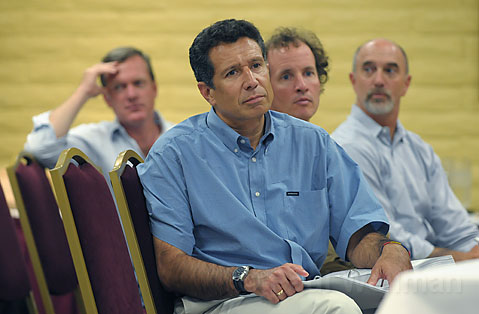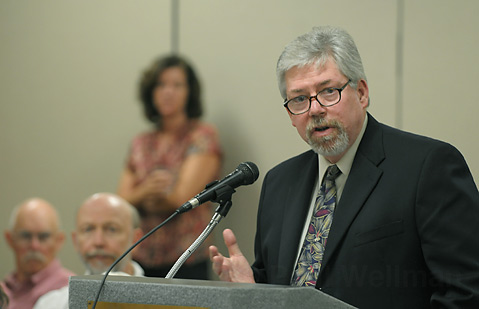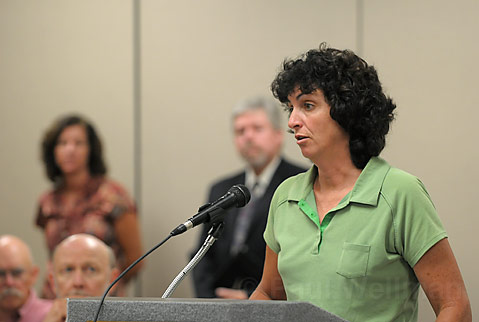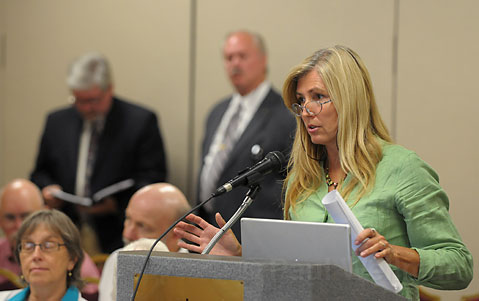Venoco Seeks Approval for Full Field Development
Public, in General, Urges Oil Company to Leave Goleta, Take Its Barge With Them

A variety of views exist with regard to Venoco’s Ellwood Marine terminal, but judging by the stakeholders and members of the public who spoke at the State Lands Commission’s public hearing on the draft environmental impact report (EIR) for the proposed Venoco Ellwood Full Field Project on Wednesday, August 6, people generally agree that the Ellwood Marine Terminal and its associated barge have worn out their welcome in the Good Land.

Currently, oil is pumped from Platform Holly – located offshore south of Coal Oil Point in Goleta – through a pipeline to the Ellwood Onshore Facility. Then, it travels through an onshore pipeline along Hollister Avenue to the Ellwood Marine Terminal – the facility located to the west of UCSB’s West Campus – where it is picked up via a floating connection by the barge Jovalon every ten days or so for transport to either Long Beach or San Francisco. “The overwhelming comment I heard today was, ‘We want to get rid of the barge.’ So does Venoco,” said Steve Greig, Venoco’s government relations and regulatory manager.
Venoco’s project proposal includes extending the boundaries of the Ellwood lease, with increased drilling operations to be conducted from Platform Holly and pumped through a new pipeline running west to Las Flores Canyon, where it would connect with the All American Coastal Pipeline. Processing would occur at the Ellwood Onshore Facility, and improvements would be made to it and Platform Holly in order to support increased capacity. To complete the draft EIR required by the California Environmental Quality Act (CEQA), the State Lands Commission – which owns the lease – hired Ventura based Marine Research Specialists (MRS), an outside consultant, to examine the impacts, required mitigation measures, and the project’s environmentally superior alternative. MRS looked at a number of different factors in their report, which was released last month and presented at Wednesday’s meeting. These factors included impacts to air quality, traffic, public services, cultural resources, and impacts related to any construction undertaken to expand production capabilities. Under the proposed project, daily oil production could rise from 4,000 to 12,000 barrels per day, at least for a time, said Greig.

Since CEQA requires that a developer identify several feasible alternatives to any project, the draft EIR lists five. The first is the “no project” alternative, which would not change anything. The remaining alternatives offer different options oil processing locations – Platform Holly, the Ellwood Onshore Facility, or the Las Flores Canyon facility. To transport oil to Las Flores, a pipeline would have to be constructed either on or offshore. The alternative that MRS deemed to be environmentally superior was the construction of an offshore oil and gas pipeline to Las Flores Canyon and with the decommissioning of the Ellwood Marine Terminal and Ellwood Onshore Facility and cessation of barge operations. Under this alternative, processing would occur at the Las Flores Canyon facility.
However, most of those who offered public comment at Wednesday’s hearing said that calling the end of barge operations a project benefit is a falsehood due to the Ellwood Marine Terminal’s scheduled closing in five to eight years. About 15 people showed up at the 3 p.m. session of the hearing, including Steve Chase, Goleta’s Director of Planning and Environmental Services. Chase cautioned against the “forevermore processing of oil and gas that is occurring in this neck of the woods,” stating that the continued use of the Ellwood Onshore Facility for processing goes against the provisions of the Goleta General Plan, which has the area zoned for recreation. “Development agreements cannot supersede a General Plan,” he said, requesting that the specifications of Venoco’s lease from the State Lands Commission be appended to the EIR. “If they really want that oil, they need to put something on the table – a predictable end date,” he said in an interview. Linda Krop, lead counsel for the Environmental Defense Center, said that the life of the lease should be explained in the project description.

A number of others echoed Chase’s sentiments, but concerns were also raised about the impacts on air quality, impacts on the surrounding communities, and the hazards of using aging facilities to continue working – none of which they said were addressed in the draft EIR. “Some of these facilities are very old, and we have a grave concern about the continued use of those facilities,” said Carla Frisk, representing Get Oil Out. Cristina Sandoval, director of UCSB’s 158-acre Coal Oil Point Reserve, conducted an independent study indicating that the number of complaints called in by residents was much higher when the barge was operating offshore, and that the air quality monitor Venoco placed near EOF does not register accurately due to the prevailing winds in the area. “I’d like to know what I’ve been exposed to, and what are the long-term effects of that exposure,” she said. Sandoval and others also wanted the document to address the potential impacts of a spill on the five endangered species that live on and around the reserve.

A few factions in favor of the project spoke as well, namely Tom Becker – an equipment sales rep from ASSET, who praised Venoco’s pledge to use ASSET’s more environmentally friendly diesel engines to reduce emissions to 2016 levels – and Tom Blabey, from the Goleta Valley Chamber of Commerce. The Chamber does not support the draft EIR’s environmentally superior alternative because from a business perspective, Blabey said, it doesn’t make much sense to process oil at Las Flores Canyon, which is owned by ExxonMobil. “The potential environmental impacts have only been moved, not reduced,” he said. In the wake of the 58,000 gallon spill that occurred last November when an oil barge struck the Bay Bridge, the decommissioning of Venoco’s aging, tug-propelled barge took on a special urgency. “Expediting the EIR process will require Venoco to construct a safer facility sooner rather than later,” said Blabey.
“I think the most important comment I heard was, “Let’s get through this process quickly,” said Greig, referencing comments made by Becker, Blabey, and Chamber of Commerce chair Jim Knight. “The first oil in the pipeline is the last barge.” However, the voices of speakers who stepped up to the podium wanting a more thorough analysis of the draft EIR, with more information given about potential impacts and required mitigation, were persistent. “We want specific, enforceable mitigation measures,” said Krop. A few requests were also made for the document to look outside the bounds of oil production to examine the feasibility of alternative energy production as a way to mitigate impacts in the area. “We should not sell our health and the environment for the false promise of cheap gas and oil,” said Barbara Massey of the Goleta Citizens’ Planning Association.



